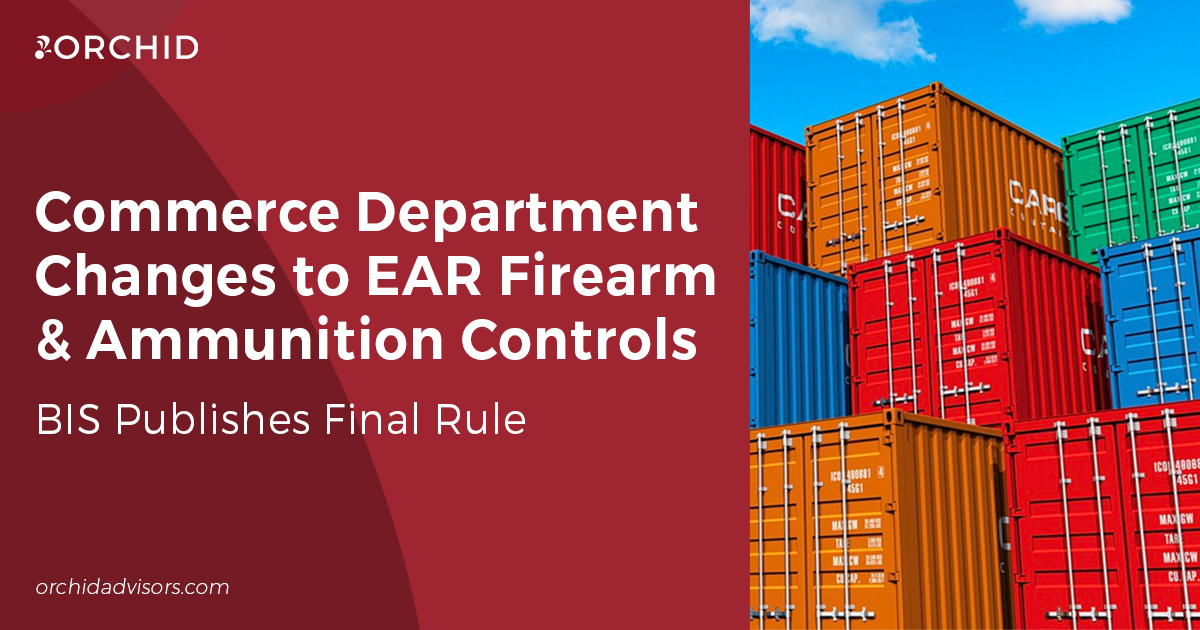Yesterday, the Bureau of Industry and Security (BIS) published a Final Rule of technical corrections to the March 2020 Export Control Reform, addressing firearms, ammunition, and related items moved to the Export Administration Regulations’ (EAR) Commodity Control List (CCL).
Informed by fielded questions and industry outreach, the changes are intended to make requirements easier to understand, provide for consistent interpretation and ensure the requirements are in accordance with the intent of the Commerce Department’s January 23, 2020 rule.
Highlights of the new Final Rule include:
- Clarifying a current import permit must be received by the U.S. exporter from the receiving foreign party prior to export and maintained as an export record. This becomes important after the initial import permit expires prior to the expiration of the associated BIS license. Many import permits expire after 1 year, whereas a BIS license is normally valid for 4 years. (§ 748.12(d) and (e))
- To avoid submitting a Conventional Arms Report to BIS semi-annually (§ 743.4(b)), clarifying when accomplishing the Electronic Export Information (EEI) filing within the Automated Export System (AES), the ECCN subparagraph identifier (the “items” level classification) should be first text to appear in the Commodity description block. (e.g., “.a” for an ECCN 0A501.a firearm; “SB” for and ECCN 0A502 shotguns with barrels less than 18” in length)
- Clarifying the ECCN 0A501.e term “frames (receivers)” refers to any “part” or “component” of the firearm that has, or normally has, a serial number when required by law and the ATF regulates as a “firearm.”
- Expanding ECCN 0A501.y.1 description of “stocks” to include “adjustable, collapsible, blades, and braces” and adds “handguards or forends” to list of controlled parts.
- Identifying previously controlled items under ECCN 0A501.y.2 to y.5 (“scope mounts or accessory rails; iron sights; sling swivels; and butt plates or recoil pads”) are now EAR99.
- Identifying a receiver incorporating any other controlled “part” or “component,” such as a barrel under 0A501.c, remain controlled under 0A501.e.
- Providing guidance on how to export classify ECCN 0A501 related firearm kits and clarifies a complete firearm disassembled in kit form is a firearm.
- Clarifying ECCN 0A505.b controls any buckshot shotgun shells where the projectile(s) is “any material,” such as rubber, plastic, or incorporates chemical irritants as the shell projectile(s). This moves shotgun shells with chemical irritants from ECCN 1A984 to 0A505.b.
- Identifying “marking rounds,” (i.e., ammunition rounds with paint or dye as the projectile) are export classified as ECCN 0A505.d.
- Expanding ECCN 0A505.x and associated new Note 3 (previously Note 4) to 0A505 to reflect a more general ‘metal’ description than the previously used limiting description of copper and lead.
Effective September 20, 2021, the Final Rule changes are published in the Federal Register for the Control for Firearms, Guns, Ammunition and Related Articles subject to the EAR. Exporters are urged to review the rule in detail to fully understand the new EAR export controls and compliance requirements.
Contact Orchid to speak to our U.S. Export Control and Compliance specialists about implications for your FFL and how Orchid eXport™ services can expand your international business.







0 Comments